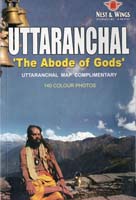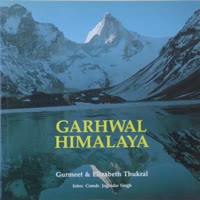| Guides and maps | Other books | Delhi | Accommodation | |||||||
| Food | Drink | Weather | Roads | Money | Misc | |||||
Guides and maps
For
 |
When we arrived in Delhi we were able to obtain the Nest & Wings guide shown on the left. This is very helpful and comes with a road map which marks distances and indicates which places have hotels and resthouses. However it should not be relied on uncritically in respect of altitudes.

Nest & Wings have a web site [dead link], and if we’d had more confidence we’d have attempted an online order in advance.
Military maps are pretty, but of little practical use. Most of the route lies on the Dehra Dun sheet; small parts lie on 3 adjoining sheets; and the rectangle is completed by the Simla sheet (more useful for Kinnaur) and by grid region NH44-2 (which falls wholly in Tibet and probably does not form part of the series). We have downloadable versions linked from the thumbnail.
Other books
Our
 |
The Shipton and Tilman books on Nanda Devi are well worth reading. A modern account of the same mountain is by Hugh Thomson: ‘Nanda Devi: a journey to the last sanctuary’. It’s a brisk and interesting read.
Jim Corbett’s Man-eating leopard of Rudraprayag is worth reading both for the events it narrates and for the light it casts on the lives of Garhwali peasants 80 years ago.
Land transport
The rule of taxis is that the price per kilometre halves with each journey. At first you’re fleeced by hotel travel agents, then your innocence is exploited by savvy drivers, but eventually you learn the going rate and refuse to pay above it. More determined bargainers can probably get to a fair price more quickly than we did.
The journeys to and from Delhi took longer than guide books suggest. I suppose there is more traffic than there used to be.
Delhi
We stayed in Claridges which was still undergoing renovation; still noisy, though not as bad as previously, and no longer moderately priced.
We had a memorable meal in the Dum Pukht restaurant at the Sheraton hotel – the best (and also the most expensive) Indian food we’ve ever eaten.
Accommodation
GMVN Barkot |
The Garhwal tourist office GMVN runs a chain of resthouses throughout the state. These seldom achieve the levels of comfort of the best private hotels, but nor do they fall to the low standards of the worst, so they are often the best choice. Some of them seem to have been initially designed as prisons or barracks. The management lacks dynamism but tend their gardens lovingly. Private hotels often fail to live up to their glitzy façades.
Clean bedding and topsheets are rarities. In cold places eiderdowns are provided which give surprisingly little warmth for their weight. It’s a good idea to take a sleeping bag.
When hot water is provided centrally it seems only to be available in the mornings, which is not when cyclists need it. When there is a boiler (locally ‘geyser’) in the bathroom you can switch it on when you arrive; this is the norm in GMVN resthouses. When all else fails, hot water can nearly always be obtained in buckets.
We carried a tent with us for emergencies but never used it, and wild camping is likely to be difficult owing the the density of vegetation. Lower altitudes are intensively cultivated; middle altitudes are forested; and only above 2500m or so do you find open ground.
Food
For lunch and dinner the food provided is dhal, rice, chappatis and some form of vegetable dish. The flavours are pleasant but it’s monotonous fare. The chappatis are made to order and come to the table singly or in pairs. When you’ve had enough you try to signal that you don’t want any more; sometimes you are asked in advance how many you will eat. Look out for the baked aubergines, which are delicious.
We ate no meat between Mussoorie and Rudraprayag.
For breakfast we ate aloo parathas (pronounced parantas). These are potato-stuffed pancakes best eaten with spicy pickle. They’re delicious and we never tired of them.
Drink
Mineral water is fairly widely available but not especially pleasant. In sparsely populated areas you may need to carry your day’s supply, and Kedarnath seemed surprisingly devoid of it. Iodine tablets are a useful backup.
Tea is available everywhere and delicious, best drunk in the Indian manner (‘ready-made’). The spiced tea – masala chai – is a special treat. If coffee is available it is likely to be Nescafé.
We saw no alcohol between leaving Mussoorie and arriving at Delhi.
In Delhi we experimented with Indian table wine. Grover’s La Réserve red is delicious (we’d already encountered it in England). The syrah component gives it a rhonish base, the cabernet a minty Moroccan hue. Sula sauvignon blanc is refreshing and also good; Ch. Indage Riviera is not a success.
Weather
The monsoon overran in 2005. The October days were generally dry, but with a tendency of cloud to build up in the afternoon. There were a couple of evening showers in the first few days of our visit.
There was a spell of bad weather coming in from the north at the end of October. We thought at the time that this heralded winter, though statistics say that November should be the driest month. Bill Weir subsequently told us that the bad weather ended when we left.
Unfortunately November is not a practical month for tourism. The temple idols descend to their winter quarters around the first of the month; the pilgrimage traffic ceases; and the hotels close their doors.
Roads
 |
Nearly all the roads we cycled were tarmac, generally not much wider than a bus. There was no shoulder.
The surface is very uneven, and your speed is limited on descents by the amount of shaking you are prepared to tolerate. It is very rare to encounter a sustained gradient greater than 5%.
Traffic was enough to be disagreeable on the main road south of Uttarkashi and between Kaudi Yala and Rishikesh. Elsewhere it was generally very light.
Signposting is not bad, but because of the paucity of western visitors a few of the signposts are in Devangari only. It’s worth becoming acquainted with some of the salient consonants. Otherwise you probably won’t have to wait long to find someone to ask.
The pilgrimage trails are built to a high standard (better than, say, Chilean roads), but for a number of reasons are no place to take a bike.
Money
We changed money in Delhi and drew out a little more from an ATM in Mussoorie. We had been advised that exchange was not possible in the hills, and this seems to have been largely true. But ATMs were advertised in Joshimath and Badrinath.
Misc
We had organised this trip in a hurry, revised our plans on the spot, and ended up undertaking a gruelling but satisfying tour. It would be difficult to suggest what to omit if time is limited, but if you have time for only 3 dhams it might be best to leave out Yamunotri and begin with the Bhagirathi valley.
It’s easier to suggest extensions, some of which Bill Weir was able to take in. The Malari road is irresistable on the map: it needs an Inner Line Permit, obtainable in Joshimath. There are also mountain roads in the east of Kumaon.
The Char Dham route could be made less arduous with no loss of quality if you were in a position to take a support vehicle, which could serve the additional purpose of carrying in goodies from the plains.
The traditional pilgrimage route takes in the sites from west to east, and this makes most sense climatically for an autumn visit. In spring climate would suggest the opposite direction, but since June is the peak for Indian visitors it might be rather hectic.